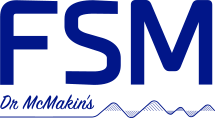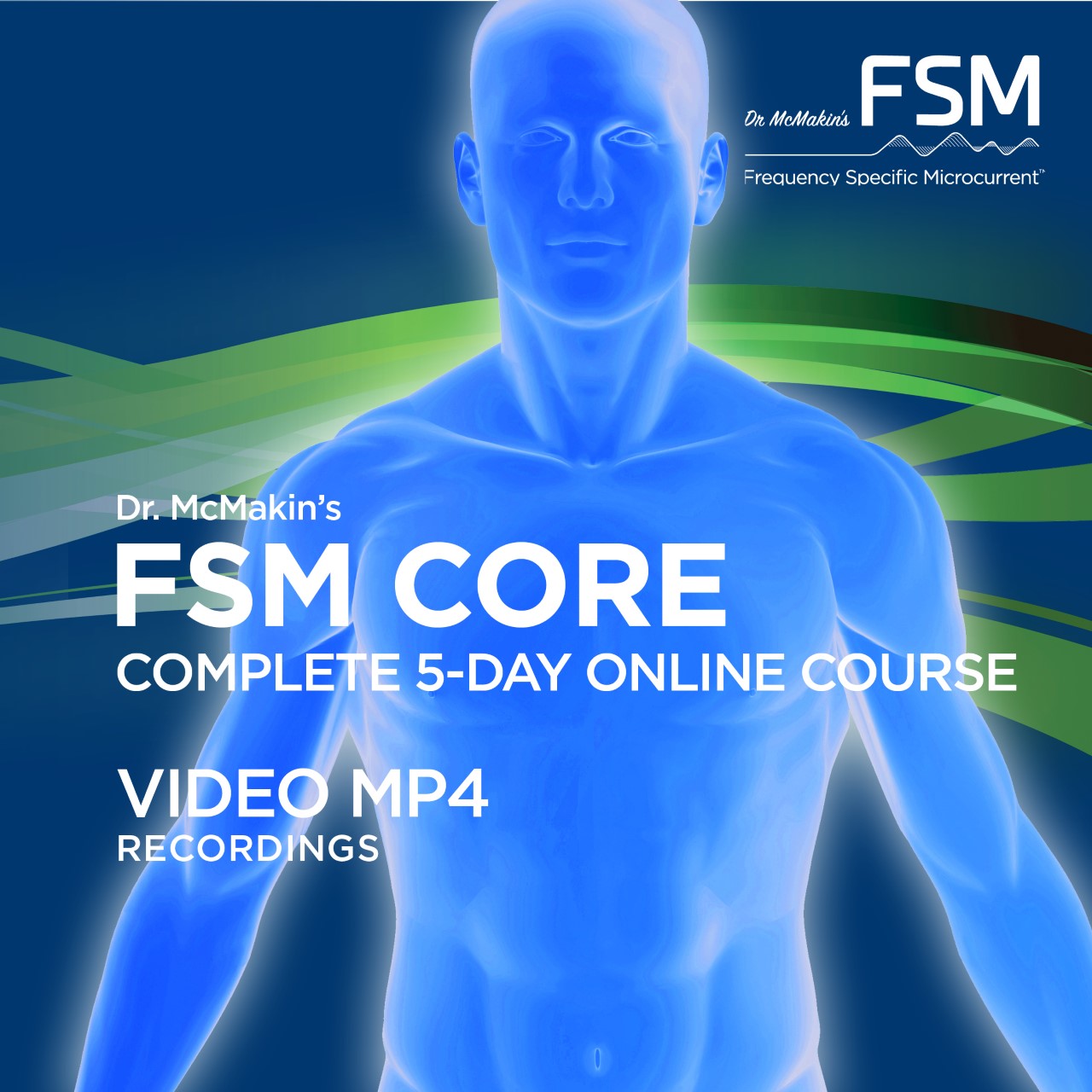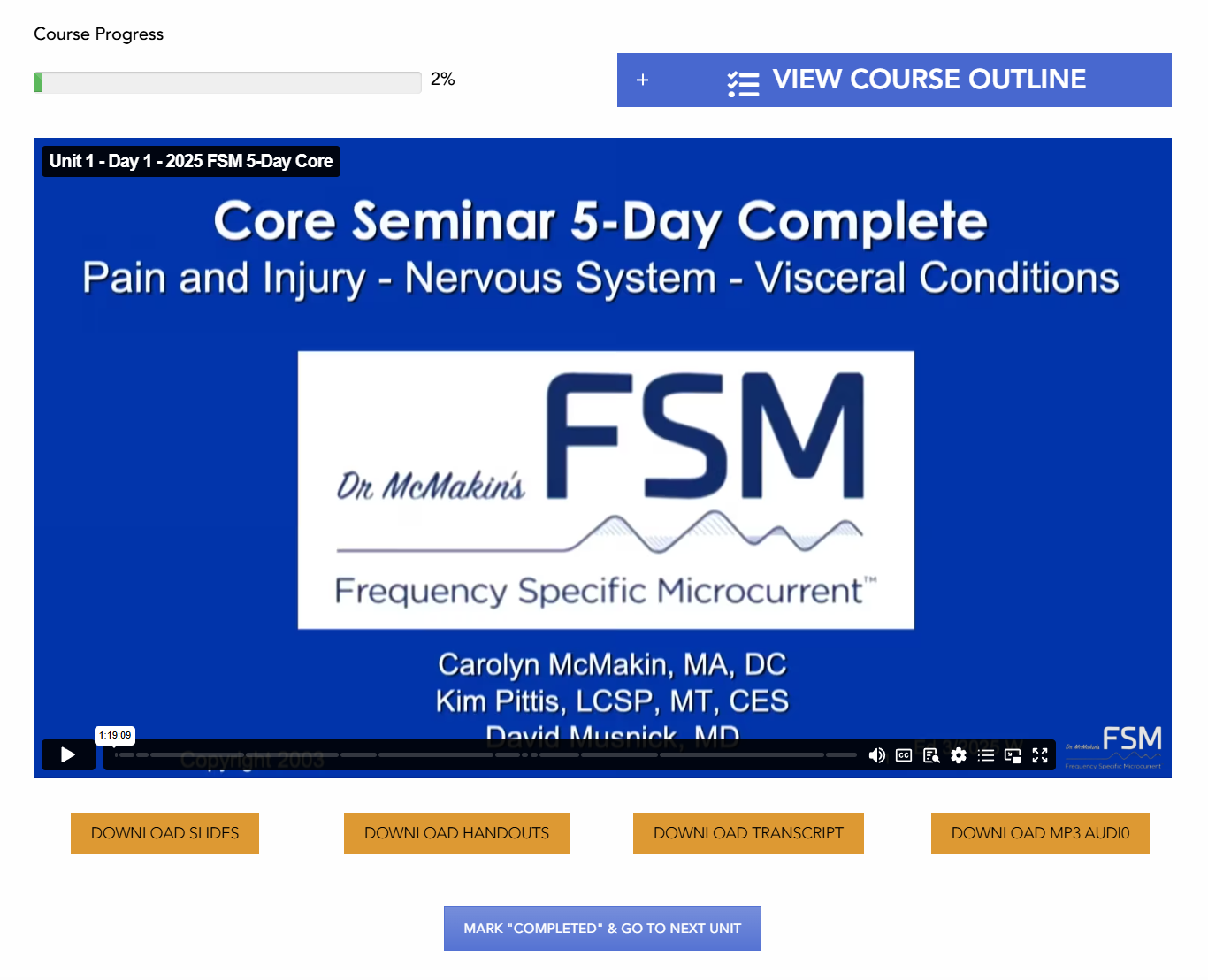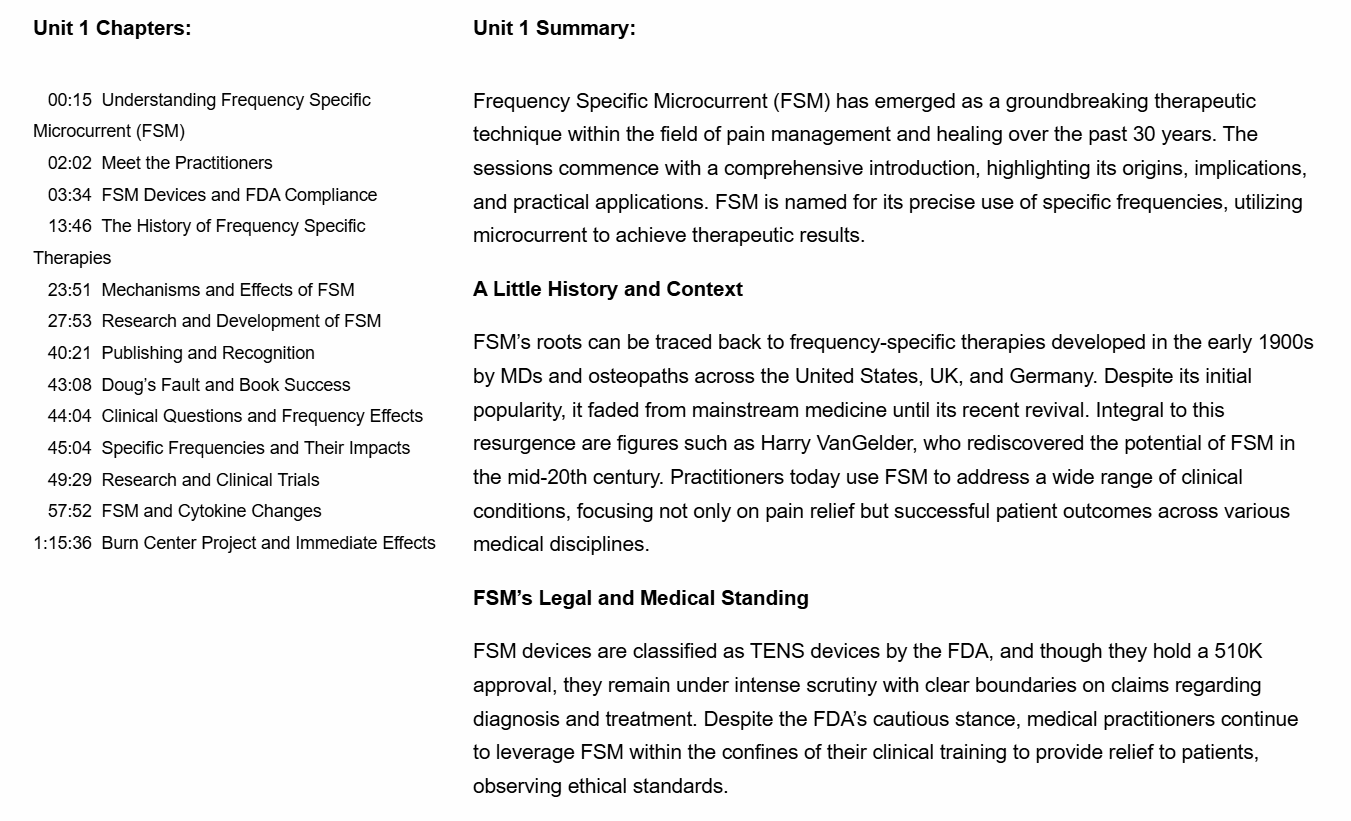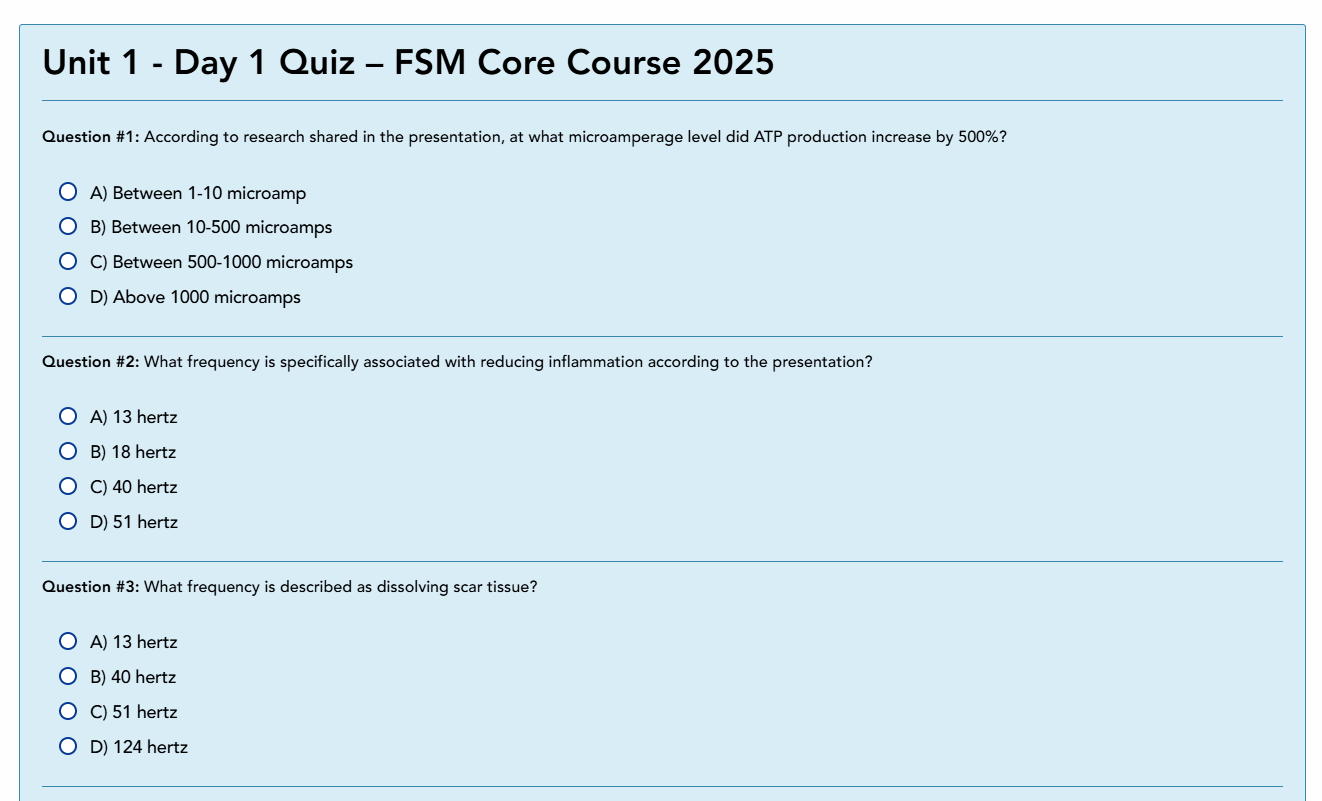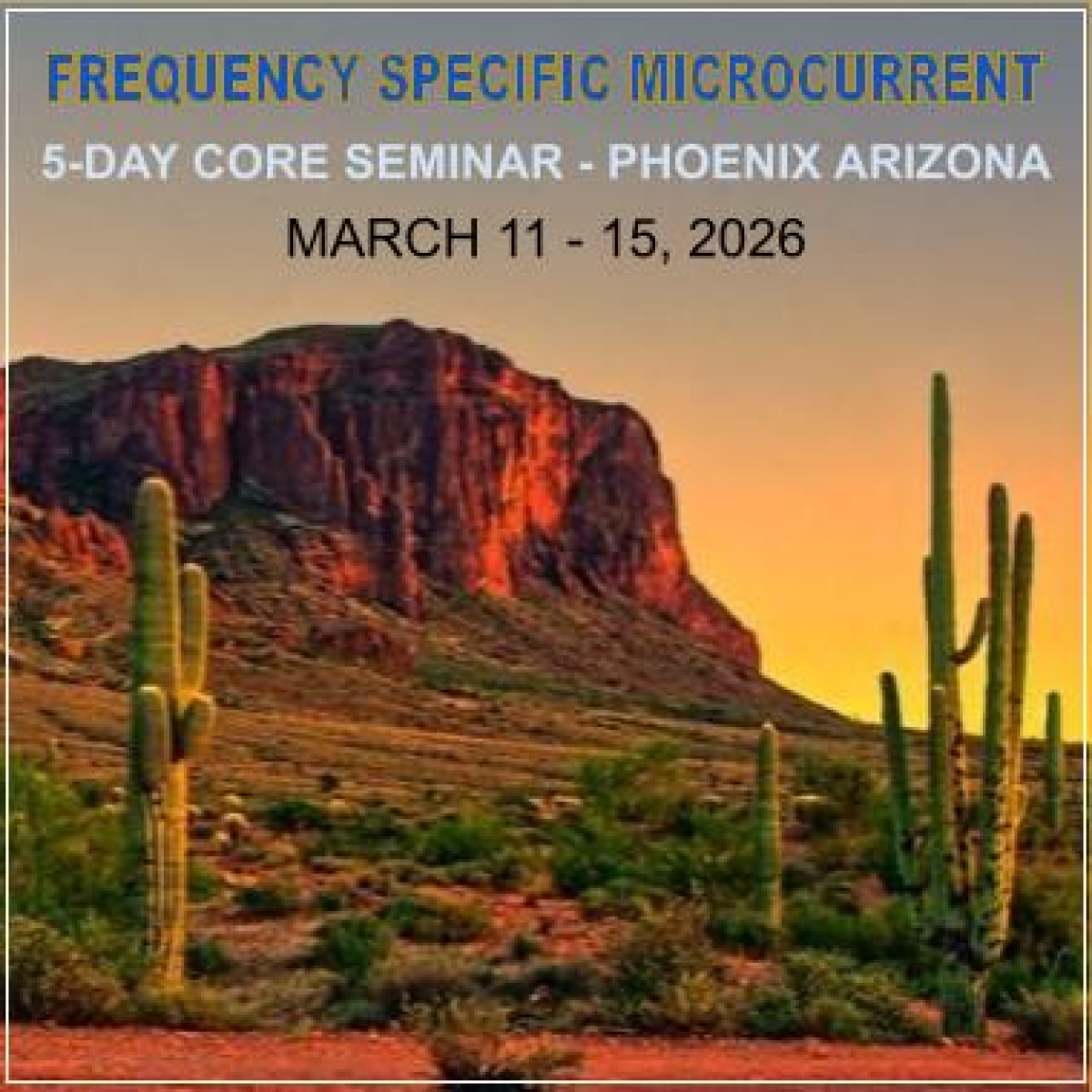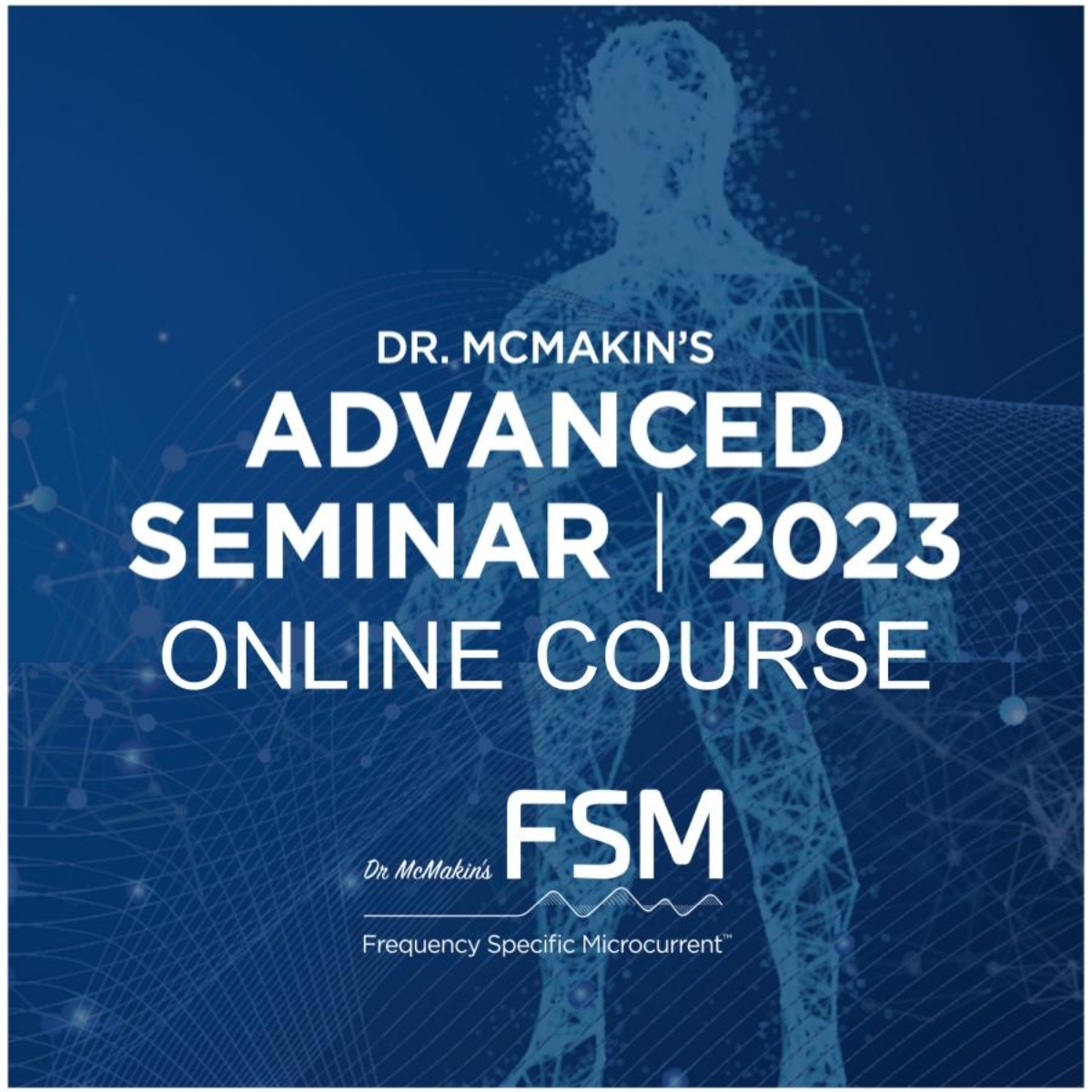| Part 1 |
Welcome - Course Guide |
|
| Part 2 |
Slides - Handouts - Documents - Forms |
|
| Part 3 |
Taking Notes Using iPad (Optional) |
|
| Part 4 |
FSM Equipment |
|
| Part 5 |
Continuing Education - CEUs - CMEs |
|
| Part 1 |
Unit 1 - Day 1 - 2025 FSM 5-Day Core |
|
| Part 2 |
Unit 2 - Day 1 - 2025 FSM 5-Day Core |
|
| Part 3 |
Unit 3 - Day 1 - 2025 FSM 5-Day Core |
|
| Part 4 |
Unit 4 - Day 1 - 2025 FSM 5-Day Core |
|
| Part 1 |
Unit 5 - Day 2 - 2025 FSM 5-Day Core |
|
| Part 2 |
Unit 6 - Day 2 - 2025 FSM 5-Day Core |
|
| Part 3 |
Unit 7 - Day 2 - 2025 FSM 5-Day Core |
|
| Part 4 |
Unit 8 - Day 2 - 2025 FSM 5-Day Core |
|
| Part 1 |
Unit 9 - Day 3 - 2025 FSM 5-Day Core |
|
| Part 2 |
Unit 10 - Day 3 - 2025 FSM 5-Day Core |
|
| Part 3 |
Unit 11 - Day 3 - 2025 FSM 5-Day Core |
|
| Part 4 |
Unit 12 - Day 3 - 2025 FSM 5-Day Core |
|
| Part 1 |
Unit 13 - Day 4 - 2025 FSM 5-Day Core |
|
| Part 2 |
Unit 14 - Day 4 - 2025 FSM 5-Day Core |
|
| Part 3 |
Unit 15 - Day 4 - 2025 FSM 5-Day Core |
|
| Part 4 |
Unit 16 - Day 4 - 2025 FSM 5-Day Core |
|
| Part 1 |
Unit 17 - Day 5 - 2025 FSM 5-Day Core |
|
| Part 2 |
Unit 18 - Day 5 - 2025 FSM 5-Day Core |
|
| Part 3 |
Unit 19 - Day 5 - 2025 FSM 5-Day Core |
|
| Part 4 |
Unit 20 - Day 5 - 2025 FSM 5-Day Core |
|
| Part 1 |
FSM Advanced and Symposium |
|
| Part 2 |
Join The FSM Practitioners Private Facebook Group |
|
| Part 3 |
FSM Webinars |
|
| Part 4 |
FSM Practitioner Directory Listing |
|
| Part 5 |
FSM-Buddy Frequency Lookup Mobile App |
|
| Part 6 |
FSM Advanced Compendium Handouts |
|
| Part 7 |
FSM Practicum Video Library |
|
| Part 8 |
Prescribing CustomCare To Patients |
|
| Part 9 |
FSM Certification Process |
|
FSM 5-Day Core Syllabus
These protocols and educational content have not been evaluated by the FDA. This course is for educational purposes only. FSM applications are not intended to diagnose, treat, cure, or prevent any disease and should be used as adjunct therapy within the practitioner’s scope of practice.
Course topics, goals, and objectives:
The course covers basic microcurrent information and the use of specific frequencies and protocols thought to address specific tissues and conditions based on the principles of biological resonance. The first part of the course focuses on the frequencies and protocols used to address chronic myofascial pain, new injuries and injuries less than six weeks old, discogenic pain, post-concussive syndrome, and neuropathic pain. The third day of the course focuses on the frequencies needed to address visceral conditions and functional medicine applications.
At the end of the class:
- Students will independently operate a two-channel 3 digit specific microcurrent device. They are observed to be able to turn the unit on, and modify the frequencies, amperage, wave slope, and polarity functions.
- Students will independently position and place the contacts on the patient and choose appropriate protocols for cervical, thoracic, and lumbar radiculopathies and diabetic neuropathies.
- Students will demonstrate at least two protocol selections for low back pain caused by facet joint inflammation.
- Students will explain at least three key contraindications, precautions to applications, or known side effects of using Frequency Specific Microcurrent.
- Given one sample patient, students will distinguish between pain caused by spinal facet joints, discs, and lax ligaments.
- Students will independently choose at least two appropriate protocols for each of the following conditions: cervical, thoracic, and lumbar radiculopathies and diabetic neuropathies. The goal of Frequency Specific Seminars is to educate all of our students so that they will be able to accomplish these objectives independently within the scope of their own practice.
Course Content:
- Introductions/Introductory Information – 2 Hours
Proposed mechanisms of action for FSM The basic science behind resonance effects Creating a stable state for lasting effects
- Basics of FSM – 2 Hours
How to set up the device, effects of the current Frequency conventions for FSM Basic application strategies for myofascial trigger points Published papers and data supporting use in myofascial trigger points Pregnancy precaution Frequencies and data supporting use to remove or soften scar tissue and adhesions Frequency sequence strategy for addressing myofascial pain and trigger points
- Setting up the device and programming – 1 Hour
Demonstration of the use of the manual device Current and frequency applied to the group Going over the differences in an individual’s ability to detect differences between frequency effects Demonstrating effects of 6 different two-channel frequency combinations
- Frequencies and protocol sequences for myofascial pain – 2 Hours
How to tell if a frequency is correct or if it is working Protocol for addressing muscle and fascia in myofascial pain Includes contact placement and current flow directions
- Practicum – 1 Hour
Addressing myofascial pain in the neck and shoulder with the patient prone The role of the subscapularis in shoulder pain and impingement Addressing adhesions
- Assessment and protocol sequences for disc-generated pain – 2 Hours
Protocols for acute, subacute, and chronic disc disease Exercise Protocols for disc pain patients
- Differential assessment of acute and chronic facet joint generated pain – 2 Hours
Protocols for acute and chronic spinal facet joints as perpetuating factors in myofascial pain
- Differential assessment of ligamentous laxity, how to recognize it, and when and how to address it – 2 Hours
Recognize and address alar ligament instability and dural adhesions at CO-C1 – 2 Protocol for ligamentous laxity as perpetuating factor in myofascial pain
- Recognizing and addressing visceral perpetuating factors in myofascial pain and trigger points – 1.5 Hours
- Addressing extremity joints – 1.5 Hours
Addressing the shoulder and the knee Addressing arthritis in any joint Addressing myofascial pain in TMJ
- Introduction to the available microcurrent equipment useful for FSM practitioners – 1 Hour
Practical considerations in choosing equipment for any particular practice
- Supine Cervical Practicum – 1 Hour
Addressing the neck and shoulders with the patient in the supine position Review of the facet, disc, and ligament laxity contributions to cervical spine myofascial pain and dysfunction
- Addressing Injuries and trauma in week 1 to week 6 – post-injury including post-operative pain and fractures – 1.5 Hours
Frequency protocols, precautions, and application considerations in sub-acute injuries Protocols for subacute trauma from week 2 to week 6 Differential assessment of shingles when it presents so that it appears to be a new injury Protocol for shingles
- Management and protocols for acute injuries – 2 Hours
Protocols for acute trauma in the first week after injury Protocols for athletic injuries Differential assessment and protocol for shingles when it presents as if it is a new injury Protocol and published paper on prevention of delayed onset muscle soreness Protocol for post-operative care as a new injury Protocol to enhance healing in acute fracture Protocol for healed fractures that remain painful Protocol for plantar fasciitis
- Supine Lumbar Practicum – 1 Hour
Addressing the lumbar spine with the patient in the supine position Reinforcement of visceral contributions to myofascial pain in the lumbar spine Review of the mechanics and considerations in facet and disc contributions to lumbar spine dysfunction
- Introduction to addressing the nervous system with FSM – 2 Hours
The basic organization of the central nervous system Frequencies for the nervous system Concepts in addressing concussion, TBI, and MBTI Frequencies associated with pathologies for CNS and ANS dysfunction Review of functions of different brain areas Protocol for post-concussive syndrome Protocols for sub-acute and chronic neurodegenerative conditions Data documenting effects of FSM in post-stroke patients with aphasia Protocol for migraine
- Introduction to assessment and mechanisms of vestibular injuries – 1.5 Hours
Possible side effects in concussed patients who also have vestibular injuries Assessment and pathophysiology of vestibular injuries Management of vestibular injuries
- Nervous system protocols – assessment and pathophysiology – 2 Hours
Addressing “brain fog” in a clinical setting Protocol for sleep disturbance Assessment and protocol for PTSD Data demonstrating effects of FSM in PTSD Protocol for PTSD How to test and track improvement in PTSD symptoms
- Differential assessment and pathophysiology of Fibromyalgia and its different causes – 1.5 Hours
Protocol for fibromyalgia associated with spine trauma – Protocol and technique for addressing Dural adhesions
- Protocols for addressing neuropathic pain including cervical, thoracic, and lumbar radiculopathies – 2 Hours
Protocols for addressing neuropathic pain including cervical, thoracic, and lumbar radiculopathies Review of the published paper on neuropathic pain Brachial plexus traction injuries Resolving neural adhesions Protocol for reversing neuropathic atrophy Protocol for post–herpetic neuralgia Protocol for compression neuropathies, carpal tunnel, thoracic outlet, and Morton’s neuroma Protocol for diabetic neuropathies Optional review of RSD / CRPS mechanism and protocol
- Practice setting up protocol applications – 1.5 Hours
Practice setting up protocol applications for different neuropathic pain applications Dry lab no applications Optional brief extremity protocol practicum
- Visceral Applications and FSM protocols – 2 Hours
Visceral Applications and FSM protocols/Immune system Gastrointestinal system (Crohn’s, IBS, ulcerative colitis, constipation) Liver protocols and data on reducing liver enzymes Gallbladder Gout Pancreas Insulin resistance Addressing the skin Enhancing wound healing, addressing oral and genital herpes Addressing skin scar tissue and acne Skin anti-aging protocols Addressing eczema and psoriasis
- Practicum – 1 Hour
Practitioners work together in small groups and choose who and what to address within their own group based on the chosen person’s symptoms.
- Assessment and protocols for visceral tissues and systems – 3 Hours
Addressing the endocrine system (adrenals, thyroid, goiter) Protocols for breast health Addressing the Lymphatics and lymphedema Protocols for the reproductive system (vaginal scarring, vulvodynia, ovarian cysts, uterine fibroids) Protocols for the respiratory system (Asthma, bronchitis, COPD, sinus, common cold) Addressing the cardiovascular system – precautions and protocols FSM protocols for emotional conditions and emotional conditions associated with pain complaints Wrapping up – dates for the Advanced course, the certification process.
Continuing Medical Education (CEUs) and Continuing Medical Education (CMEs) – Frequency Specific Microcurrent Online Course
Earn CEUs with the Most Comprehensive FSM Training Available
CEU Information & Course Benefits
This Training Offers More Than Just CEUs – It’s an Investment in Your Practice
Fulfill your continuing education requirements while learning Frequency Specific Microcurrent – unlike any other CEU training available. This comprehensive course provides the evidence-based training that will transform how you treat patients and expand your therapeutic capabilities.
FSM: The Perfect CEU Course for Your Medical Specialty Whether you’re earning CEUs as a physician, physical therapist, acupuncturist, or other healthcare professional, FSM enhances your existing skills and gives you powerful new tools. Think of it as an extension of your hands – a precise, scientific approach that complements everything you already do in practice.
Earn CEUs Directly from the Founder Dr. Carolyn McMakin didn’t just develop FSM – she revolutionized frequency-based healing. This CEU training gives you direct access to decades of clinical experience and research while fulfilling your license requirements.
Why Choose This CEU Course
Earn CEUs While Transforming Your Practice:
Unparalleled Expertise: Earn your continuing education credits directly from Dr. Carolyn McMakin, the founder and leading authority on Frequency Specific Microcurrent. This isn’t secondhand knowledge – you’re getting the source material while fulfilling your CEU requirements.
Comprehensive Clinical Applications: This CEU training covers real-world applications you can use immediately in your practice. Watch actual treatment sessions, learn proven protocols, and understand the science behind why FSM works – all while earning the credits you need.
Perfect CEU Complement to Your Specialty: FSM doesn’t replace what you do – it enhances it. Whether you’re treating pain, inflammation, neurological conditions, or tissue healing, this CEU course gives you precision tools that work alongside your existing expertise.
Evidence-Based CEU Credits: This isn’t alternative medicine – it’s science-based therapy with measurable outcomes. Earn your continuing education requirements while learning research, understanding mechanisms, and seeing clinical results.
Maximum CEU Value: Not only do you fulfill your continuing education requirements, but you also gain skills that will transform your practice and improve patient outcomes for years to come.
CEU Accreditation and Approval
Current Board Approvals:
- California Acupuncture Board – Approved Provider
- California Physical Therapy Board – Approved Provider
Additional State Approvals: If your state medical board requires specific course pre-approval or provider documentation, please contact us. We will work with you to meet all requirements for CEU acceptance in your state.
CEU Award Information
Total CEUs Available: Determined by individual licensing boards Contact Hours: 40 hours of comprehensive instruction
Course Level: Intermediate to Advanced
Delivery Method: Self-Paced Online Video Course (classroom lectures and treatment practicums)
Advanced FSM Course also available for additional continuing education
Eligible Professional Categories
This course provides continuing education credit for licensed healthcare practitioners including:
- Licensed Acupuncturists (L.Ac.)
- Physical Therapists (PT, DPT)
- Physicians (MD, DO)
- Chiropractors (DC)
- Massage Therapists (LMT)
- Nurses (RN, LPN)
- Other healthcare professionals with scope of practice allowing electrotherapy
Note: Participants should verify that this training aligns with their state licensing requirements and scope of practice.
Learning Objectives for CEU Credit
Upon successful completion, participants will demonstrate competency in:
1. Scientific Foundation Knowledge
- Explain the physiological mechanisms of frequency specific microcurrent
- Describe cellular and tissue effects of specific frequencies
- Analyze current research supporting FSM applications
2. Clinical Application Skills
- Identify appropriate patient candidates for FSM therapy
- Develop evidence-based treatment protocols
- Integrate FSM safely with existing treatment modalities
3. Professional Practice Standards
- Implement proper safety protocols and contraindication screening
- Document treatment outcomes using validated measures
- Apply ethical considerations in FSM practice
CEU Completion Requirements
Mandatory Requirements for CEU Credit:
- Complete viewing of all 20 video units (40 total hours)
- Participate in 8 treatment practicums by following along with demonstrated techniques
- Pass each 10-question quiz following each video unit (minimum 80% passing score)
- Submit completed course evaluation form
Assessment Methods:
- Twenty (20) individual unit quizzes, each containing 10 questions
- All quizzes must be passed to receive CEU credit
- Unlimited retake attempts available for failed quizzes
Documentation Provided
For Licensing Board Compliance:
- Official CEU completion certificate with provider approval numbers
- Detailed course completion report showing unit completion and quiz scores
- Course syllabus with learning objectives
- Instructor curriculum vitae and qualifications
- 40 contact hours verification documentation
- Course content outline and bibliography
Record Retention: All course records and documentation are maintained for seven (7) years in compliance with state board requirements.
State-Specific Requirements
Pre-Approval Process: Some state boards require course pre-approval before attendance. If your licensing board requires:
- Course content submission and approval
- Provider application and fees
- Specific documentation formats
- Additional compliance measures
We will assist you by providing:
- Detailed course submissions to your state board
- All required documentation and forms
- Follow-up communication with board representatives
- Confirmation of approval status before course attendance
CEU Certificate Information
Official Certificate Includes:
- Participant name and license information
- Course title: “Frequency Specific Microcurrent Training”
- Instructor: Dr. Carolyn McMakin, MA, DC
- Number of contact hours awarded (40 hours)
- Course completion date
- Provider approval numbers
- Official signatures and seals
Next Steps After Course Completion
Immediate Actions Upon Completion:
1. Download Your Course Completion Report
- Access your detailed completion report showing all 20 units completed
- Verify all quiz scores meet the 80% minimum requirement
- Save this report for your records
2. Complete Course Evaluation
- Submit the required course evaluation form
- Your official CEU documentation cannot be processed until evaluation is completed
3. Request Your Official CEU Documentation
- Email contact@frequencyspecific.com to request your CEU documentation package
- Include your full name, course completion date, and licensing state(s)
- You will receive:
- Official CEU completion certificate with education hours completed
- CEU hours slip
- Course syllabus with learning objectives
- Instructor curriculum vitae (Dr. Carolyn McMakin)
- Course content outline and bibliography
3. Verify with Your Licensing Board
- Inform us of your licensing state(s) for proper certificate formatting
- Request any additional documentation required by your specific board
- We will provide state-appropriate formatting and approval numbers
4. State-Specific Documentation
- Inform us of your licensing state(s) for proper certificate formatting
- Request any additional documentation required by your specific board
- We will provide state-appropriate formatting and approval numbers
5. Verify with Your Licensing Board
- Confirm CEU acceptance with your state licensing board
- Submit documentation according to your board’s requirements
- Keep copies of all submitted materials for your records
Multi-State Practitioners
If you hold licenses in multiple states, please inform us during registration. We can provide documentation formatted to meet the specific requirements of each state’s licensing board.
CEU Credit Verification
For License Renewal:
- Certificates include all information typically required for license renewal
- Provider verification available for board audits
- Course transcripts available upon request
- Direct board communication available if required
Record Keeping
- Maintain all course documentation for your license renewal period
- Course records are kept on file for 7 years for verification purposes
- Duplicate documentation available upon request
Contact for CEU Questions
Before Registration:
- Verify course approval status in your state
- Confirm CEU acceptance with your licensing board
- Request pre-approval documentation if required
After Course Completion:
- CEU documentation requests: contact@frequencyspecific.com
- Certificate issues or replacements
- Board verification requests
- Documentation for audits
Important Notice: While we maintain approvals with California boards and work to meet other state requirements, participants are ultimately responsible for ensuring CEU acceptance with their individual licensing boards. We recommend confirming approval before registration and are committed to providing all necessary documentation to support your continuing education requirements.
$1695 First-Time Practitioner – You have not taken an FSM Core course from Dr. McMakin. Online course students will receive a 4-hour tutorial credit with a trained FSM practicum instructor or you can attend a practicum weekend when available.*
$849 – Current FSM Practitioner – You have previously attended an FSM Core seminar or taken a Core online course from Dr. McMakin.
$849 Practitioner Assistant – You have an assistant working for you that you would like to have trained. You must be a current FSM practitioner who has attended or is currently enrolled in a non-discounted FSM Core course from Dr. McMakin. Unlicensed assistants can treat with FSM under your license and can increase your productivity.
$849 Currently Enrolled Medical Student – You are currently enrolled in a medical/clinical training program and do not have an active clinical practice yet. To request approval for this discount please contact us.
FSM Equipment – After your registration has been approved you will receive an email regarding equipment options, pricing, and a discount coupon.
Q: How is FSM different from other electrotherapy I already know? A: FSM uses specific frequencies (measured in Hz) that target particular tissues and conditions, unlike TENS or other electrotherapy that uses random frequencies. Each frequency combination has been researched for specific therapeutic effects – it’s precision medicine, not general stimulation.
Q: Will this work with my current scope of practice? A: Yes – FSM enhances what you already do rather than replacing it. It works alongside physical therapy, chiropractic adjustments, acupuncture, medical treatments, and massage therapy. Most practitioners find it amplifies their existing results.
Q: Is there real science behind this, or is it alternative medicine? A: FSM is evidence-based with peer-reviewed research showing measurable physiological changes. Studies demonstrate increased ATP production, reduced inflammation markers, and accelerated tissue healing. Dr. McMakin has published extensively in medical journals.
Q: How quickly will I see results with patients? A: Many practitioners report seeing improvements in patient outcomes within their first few treatments. Pain reduction is often immediate, while tissue healing effects build over multiple sessions. You’ll learn to recognize and measure these changes.
Q: Do I need to buy expensive equipment? A: FSM devices are significantly less expensive than most medical equipment. The course covers equipment options and costs, but the return on investment is typically rapid due to improved patient outcomes and retention.
Q: Will my patients accept this treatment? A: Patients love FSM because it’s comfortable (they barely feel it), non-invasive, and produces results they can feel. Most practitioners find patient compliance and satisfaction increases dramatically.
Q: How long does it take to become proficient? A: The 40-hour course gives you everything needed to start treating patients safely and effectively. You’ll learn established protocols for common conditions, and confidence builds quickly with each successful treatment.
Q: Can I integrate this into my busy practice schedule? A: Yes – FSM treatments can run while you’re doing other therapies or documentation. Many practitioners use it during existing treatment time to enhance outcomes without extending appointment length.
Q: What if FSM doesn’t work for my patient population? A: FSM has applications across virtually all medical specialties – from acute injuries to chronic conditions, neurological issues to post-surgical healing. The protocols cover the conditions you’re already treating.
Q: Is this just another passing trend in healthcare? A: FSM has been in clinical use for over 25 years with growing adoption by major medical centers and sports medicine practices. The science continues to strengthen, and clinical results speak for themselves.
Q: How does this compare to other CEU courses I could take? A: Most CEU courses give you information you’ll never use clinically. This course provides skills you’ll use immediately with every appropriate patient, transforming your practice effectiveness while fulfilling your education requirements.
Q: What kind of support do I get after the course? A: You’ll have access to ongoing clinical support, updated protocols, and a community of FSM practitioners. This isn’t just a one-time course – it’s entry into a network of advanced practitioners.
